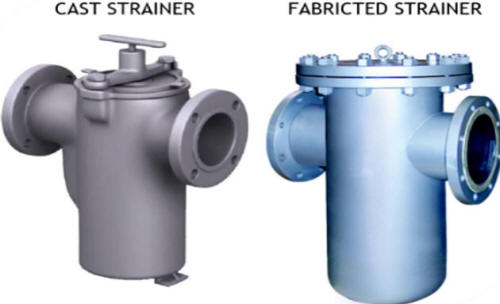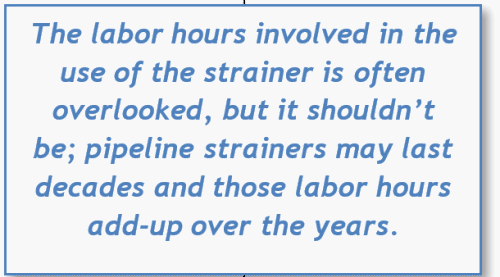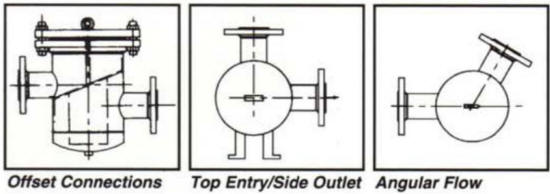Comparison of Fabricated and Cast Strainers
Which do you need - a cast or fabricated basket strainer design?

Pipeline strainers are often considered a commodity product because the primary design criteria are considered “universal”:
PRIMARY DESIGN CRITERIA
1.
material of construction
2. connection type
3. connection size
4.
style simplex, duplex or automatic
5. element retention
This article explains the differences of cast and custom fabricated strainer designs, complementing the following articles:
-
How to Compare and Select Cast Simplex Strainers, Avoid the pitfalls related to relying on only size and cost
-
How to Select a Pipeline Strainer, Three design criteria for proper strainer selection
-
Effects of Fluid Velocity and Differential Pressure on Pipeline Strainers, Considerations for proper strainer sizing
Simply put, most customers use fabricated strainers
to maximize filtration efficiency for their specific application. Sometimes
the liquid characteristics or engineering specifications necessitate using a
custom fabricated design, but you can benefit from using a custom fabricated
strainer design even when a cast design would work.
Open Area Ratio
Cast strainer
designs have a fixed open area ratio (OAR); this is the ratio of the open
area of the filter element to the open area of the inlet nozzle. As this
ratio increases the frequency of element cleaning decreases. The OAR is
mostly dictated by the strainer design, with Y and T styles having low
ratios (1:1 or 2:1) and basket strainers of 5:1 or better OARs.
Although it is not a guarantee, most fabricated strainers have a higher OAR
than cast strainers and that is because cast strainers are designed to
minimize cost. It is possible to cast strainers with thinner wall
thicknesses and overall smaller dimensions compared to their fabricated
versions which are physically larger due to the required welding procedures.
 OAR
Trade-Off
OAR
Trade-Off
You might enjoy an initial cost savings and
quicker delivery purchasing a cast strainer at the expense of more frequent
basket cleanings. Labor hours related to strainer maintenance are often
overlooked during the procurement process, but it should not because pipeline strainers
last decades and those labor hours add-up over the years. Its not only labor
hours, personnel exposure to the process liquid and spillage contribute to
overhead costs also.
Applications Requiring Fabricated
Strainers
Some applications require features which cannot be
provided in cast designs, for example allowing for corrosion. Due to the
manufacturing technique for cast strainers it is not possible to customize
the thickness of the body or nozzles. Such strainers have varying wall
thicknesses with the design meant to withstand a certain pressure and
temperature combination and cannot be altered from the tooling used at the
foundry.
Fabricated strainers can be made from thicker materials,
their connections can be customized by size, type and location and they are
available in exotic alloys that cast versions are not.
Examples of Customized Fabricated Strainers
One of the most common customizations differentiating fabricated strainers
from cast strainers is attaching smaller sized connections to match the
pipeline it will be installed into; this is done to improve the OAR.
Liquid can be transferred at high velocities and therefore smaller pipeline
sizes are used to reduce cost and space but this can be problematic for a
pipeline strainer. Once the inlet velocity exceeds about 10 FPS there is an
increased likelihood that the internal strainer basket is damaged. Strainer
baskets are typically sealed against the strainer body through the downwards
force the cover applies to the arched spring-like basket handle. At high
velocities the baskets begin to spin, damaging both the basket and strainer
body.
In such situations the strainer body can be
oversized, so perhaps you are essentially installing a 6" strainer into a
4" pipeline. A 6" fabricated strainer can have 4" connections, doubling the
OAR from 7:1 to 14:1 and reducing the velocity by almost 50%. If a cast 6"
strainer was used, a separate transition spool would need to be fabricated
for the inlet and outlet, increasing the overall cost and number of
potential leakage points.
Mesh lined baskets reduce the OAR of a given size
strainer significantly unless offset by using a larger size basket
commensurate with a larger sized
strainer body.
Code Stamps, NDT and NDE
Only
fabricated strainers can be provided with an ASME code stamp due to the
specific manufacturing requirements related to code stamping. Applications
requiring magnetic particle testing, ultrasonic weld/wall thickness tests
and non-standard welding procedures (or even a requirement of minimum welder
qualifications) are indications that a fabricated strainer is required.
These types of requirements are often industry specific with the oil and gas
industry being notorious for ensuring stringent manufacturing and quality
control procedures are used throughout the manufacturing process.
Alternate Nozzle Locations
The basic pipeline strainer
design has inlet and outlet nozzles 180° apart at the same elevation, often
referred to as "inline". This is the most common nozzle orientation, however
there are applications which benefit from nozzles having the inlet and
outlet on the same side (referred to as "loop" configuration) and even 45°
or 90° offset. Most of the time these special nozzle
orientations are driven by limited space as might be characteristic of
portable systems located on trucks and ships.

Advantages of Cast Strainers
If your flow rate (velocity) and OAR can be satisfied with a cast strainer
then you benefit from lower costs and quicker lead times. Cast strainers are
mass produced and require less labor; the labor that is used is often
low-cost labor because most cast strainers originate from foundries in China
and India. These countries do not have the environmental and labor
protection laws that manufacturers in the USA are subject to, so it's just
not possible to cast strainers in the USA at a competitive price.
As
previously mentioned, the amount of material used for a cast product is
often less due to sophisticated tooling used by the foundry, a big factor
contributing to lower cost. So even after you account for the ocean freight
cost to North America, cast strainers almost always cost less than a locally
fabricated strainer.
Yoke Style Access Covers
Most cast strainers have quick-opening strainer basket chamber covers which require only a few turns of a T-Bolt to access the strainer basket. Fabricated designs typically have a fully bolted cover design with an option for a hinged cover and swing-bolts which add significantly to the cost of the strainer due to the extra labor.

Quick Delivery
The mass
production nature of cast strainers results in physical inventory and lead
times reduced to whatever is required to fabricate the strainer basket
(typically within 1 week). Fabricated strainers must go through a rigorous
process of drawing generation/approval, acquiring raw materials,
cutting/bending and welding procedures in addition to various
non-destructive testing (NDT), resulting in at least 4 to 6 weeks for
shipment after receipt of an order. If there are supply chain interruptions
or a backlog of orders that lead time can easily extend to 12+ weeks.
 Made
In the USA
Made
In the USA
There are increasing requirements for government
agencies and their vendors to purchase products of which 55% of their value
originates from the USA. It is difficult to supply a cast strainer for such
applications because the strainer body itself is often cast overseas. One
way around this (prior to the January 2021 update), was to re-source the
chamber cover hardware (bolts/nuts), fabricating the basket, re-testing
(hydrostatic test) the body and re-painting the strainer so it can be
considered to have enough USA value to satisfy the Buy American Act
requirements. These added parts and procedures increased the cost and lead
time, reducing the biggest advantages of cast strainers. Now that they Buy
American Act has been updatcASTed, 95% of the iron and steel content must be
of US origin to satisfy the Buy American Act. An exception can be made if
the foreign cast strainer is 20-30% less expensive than the USA version.
Let us leverage our strainer sizing and selection experience
from the previous 20 years to assist you with your next strainer
application. We approach your project from the perspective of solving a
problem or satisfying specific goals; explaining and quoting multiple
options to ensure you are making an informed decision. Our website at
https://fdpp.com has many articles, PDF files
and automated sizing tools enabling comparison of several brands of
strainers; our assistance is only a phone call or email away and has no cost
or obligation to you.



